Ozempic is a drug aimed at treating type 2 diabetes. However, for several weeks, TikTok users have been touting its appetite suppressant effects and using it even though they are not diabetics.
New trend on TikTok, praising the merits of Ozempic. The problem ? It is a drug reserved for the treatment of insufficiently controlled type 2 diabetes. The hashtag on the social network has accumulated more than 600 million views, where women mainly prick themselves in the stomach, boasting of weight loss thanks to the product.
An attitude identified and denounced in France by the ANSM (National Agency for the Safety of Medicines and Health Products) and the Health Insurance in a communicated commmon. The health authorities first recalled that in France it is a drug only available on prescription, but that “returns from the field report misuse in non-diabetic people for the purpose of weight loss”. According to health insurance calculations, nearly 2,185 Ozempic recipients are not diabetic and inject themselves with a product that is not intended for them.
As specified by the notice of the drug, it is an antidiabetic aimed at regulating blood sugar levels because “stimulates the release of insulin when blood glucose levels are high”.
Why is this trend dangerous?
First, according to the ANSM, injecting this product can cause a shortage for people who really need it, people with type 2 diabetes. This misuse “can cause, or accentuate, supply tensions” thus alerted the health agency. Then, it can also have direct consequences for users, including “potentially serious side effects, such as gastrointestinal disorders, pancreatitis or hypoglycaemia”. An endocrinologist, Jean-François Gauthier, explained on March 2 to European 1 that “in 20% of cases, it is poorly tolerated on the digestive level, that is to say that one can have nausea, vomiting via a small signal on pancreatitis”.
The leaflet of the drug also specifies that it has a long-lasting action and therefore should only be used by type 2 diabetics once a week. It is also generally necessary to couple its use with a blood glucose meter because it can cause hypoglycemia. Among its undesirable effects also cited classified in the category “infrequent” or occurring for less than one patient in ten is cited an “increased heart rate, pancreatitis, reaction at the injection site”.
The authors of the press release therefore ask pharmacies to be more vigilant. In case of doubt, pharmacists are invited to “report suspicious prescriptions to the regional health agency”.
